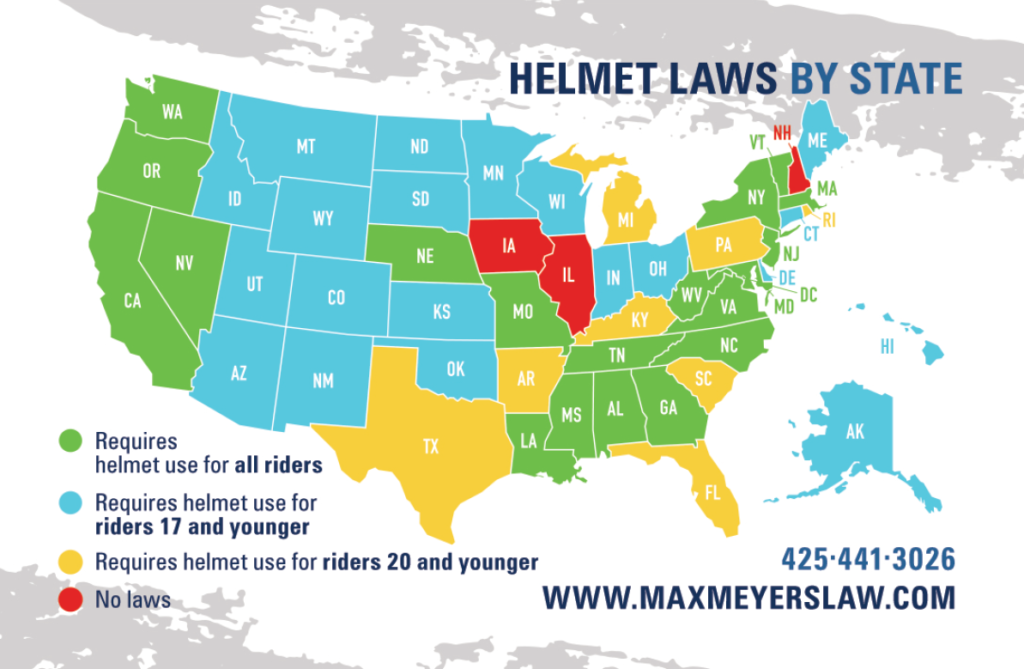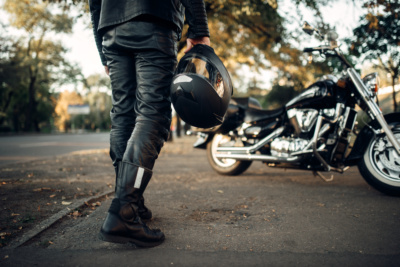Washington law states a helmet is required to be worn when operation a motorcycle, scooter or moped. RCW 46.37.530 reads:
Motorcycles, motor-driven cycles, mopeds, electric-assisted bicycles—Helmets, other equipment—Children—Rules.
- It is unlawful:
…
(b) For any person to operate a motorcycle, moped, or motor-driven cycle which does not have a windshield unless wearing glasses, goggles, or a face shield of a type conforming to rules adopted by the state patrol;
(c) For any person to operate or ride upon a motorcycle, motor-driven cycle, or moped on a state highway, county road, or city street unless wearing upon his or her head a motorcycle helmet except when the vehicle is an antique motor-driven cycle or when the vehicle is equipped with all of the following:
(i) Steering wheel;
(ii) Seat belts that conform to standards prescribed under 49 C.F.R. Part 571; and
(iii) Partially or completely enclosed seating area for the driver and passenger that is certified by the manufacturer as meeting the standards prescribed under 49 C.F.R. Sec. 571.216.
The motorcycle helmet neck or chin strap must be fastened securely while the motorcycle, moped, or motor-driven cycle is in motion. Persons operating electric-assisted bicycles and motorized foot scooters shall comply with all laws and regulations related to the use of bicycle helmets;
(d) For any person to transport a child under the age of five on a motorcycle or motor-driven cycle;
…
(3) For purposes of this section, “motorcycle helmet” means a protective covering for the head consisting of a hard outer shell, padding adjacent to and inside the outer shell, and a neck or chin strap type retention system, with the manufacturer’s certification applied in accordance with 49 C.F.R. Sec. 571.218 indicating that the motorcycle helmet meets standards established by the United States department of transportation.
Riding any two-wheeled vehicle with an engine triggers the helmet law. If you do not wear a helmet while operating a motorcycle you are breaking the law. It is important to be aware of the ramification of not wearing a helmet while riding in the state of Washington. Washington’s helmet law was first enacted in 1967. It was repealed 10 years later, followed by a new law a decade later requiring helmets for riders age 17 and younger. The current universal law was passed in 1990.
According to the Washington Traffic Safety Commission, only 3% of road users in Washington and motorcyclists. Sadly, this group accounts for 15% of all fatalities and 19% of all serious injuries in accidents between 2013 and 2017. It is estimated that 1 in 5 motorcycle accidents results in serious injury or death. 91 % of motorcycle riders involved in fatal crashes are male. On average, 75 motorcyclists die every year in Washington state accidents. The stats have stayed the same for more than a decade.
| Year | Total Traffic Fatalities | Motorcycle Fatalities | Percentage of Total |
| 2013 | 436 | 73 | 17% |
| 2014 | 462 | 69 | 15% |
| 2015 | 551 | 73 | 13% |
| 2016 | 536 | 81 | 15% |
| 2017 | 565 | 80 | 14% |
| Totals: | 2,550 | 378 | 15% |
However, we firmly believe these numbers would be much higher if helmets were not regularly used by riders. There is no question in our minds that helmets do save lives.
There has been a recent Senate Bill 5007 in Washington state that aims to repeal our current helmet law and would allow motorcyclists over the age of 21 to ride without a helmet. This would be a 3-year pilot program. Many riders support the idea of “helmet” choice, but others believe that repealing our current helmet law would be a big mistake. Whichever side of the debate you are on, it is important to understand our helmet safety laws from a legal perspective.
When a motorcycle helmet isn’t worn, besides putting your life and health at risk, you are also at risk of losing compensation in the event you suffer from a serious injury in a motorcycle accident.
Comparative negligence states that when an accident occurs, the fault and or negligence of each party involved is based upon their respective contributions to the accident. In other words, if you are riding on your motorcycle and are injured in an accident, comparative negligence can reduce the amount of damages you can recover in a negligence-based claim, based upon the degree to which your own negligence (not wearing a helmet) contributed to cause the injury.
For example, if you are in an accident and it is determined 40 percent of your head injuries were due to not wearing a helmet, then your compensation will be reduced by 40 percent.
Washington state also requires all motorcycle riders to wear helmets that meet the safety standards of the United States Department of Transportation (DOT). Here are the guidelines a certified helmet must meet (49 CFR 571.218):
-It features a thick chinstrap with sturdy rivets
-It features an inner foam lining approximately one inch thick
-Labeling inside the helmet indicates manufacturer name, helmet model, size, plus other manufacturing information
-It features a DOT sticker on the back
Prevent Traumatic Brain Injuries:
If you need more reasons to convince you that wearing a helmet is a good idea, check out these stats provided by the Centers for Disease Control and Prevention:
-According to the Centers for Disease Control and Prevention (CDC), approximately 1.7 million people sustain a traumatic brain injury (TBI) in the United States each year.
-TBI is a contributing factor in one-third of all injury-related deaths in the United States.
-Approximately 75 percent of TBIs stem from concussions or other forms of mild head injuries.
Even if you are wearing a helmet you can still suffer from a traumatic brain injury in an accident. One of our clients experienced this very thing. She was thrown from her bike and does not remember the accident due to her head injury. She was unconscious and experienced a very bad concussion and a brain bruise, along with several other injuries. She still has memory issues and doesn’t know if she will ever get her entire memory back due to the brain injury she suffered. Your brain function is nothing to gamble with, protect yourself and wear a motorcycle helmet whenever you ride.
Helmet Laws by State:

The data shows that endorsed riders are less likely to be involved in a fatal accident. A license endorsement is required in Washington state. Visit the Washington State Department of Licensing website to find out how to get your motorcycle endorsement.
Data also shows that 75% of fatal motorcycle accident victims have no record of completing a training program. There are several approved motorcycle rider training school locations that can be found in Washington state.
Protect your health and your potential motorcycle accident claim by wearing a helmet. If you were in an accident, it will help your case if you still have your motorcycle helmet to show it met the federal regulations from the DOT. Call MaxPower Law now at 425-970-9300 to set up your FREE consultation about how your helmet use can affect your motorcycle injury case.

